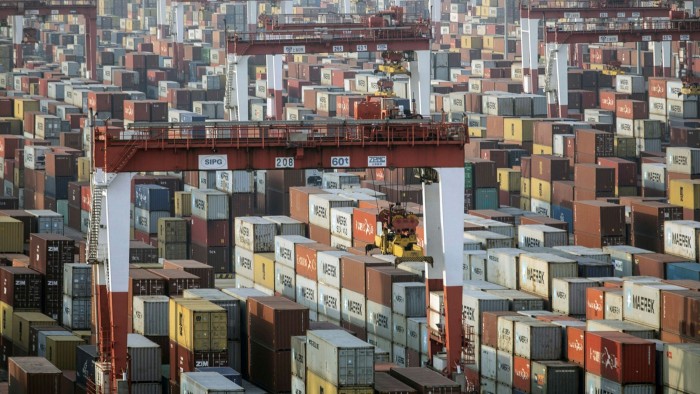Five reasons to be optimistic about the survival of globalisation


Roula Khalaf, Editor of the FT, selects her favourite stories in this weekly newsletter.
Globalisation is dead. Larry Fink of BlackRock says so. Then again, Mark Mobius of Mobius Capital Partners says he’s wrong. Which legendary investor’s views blindly to take on trust? Maybe we could take a look ourselves.
Pessimism about the survival of post-cold war globalisation looks more justified now than during the multiple previous episodes when its demise was confidently but wrongly predicted. (For the record, these include the bursting of the 1990s tech bubble, the 9/11 attacks, the Sars outbreak of 2003, the avian flu outbreak of 2005, the 2007-08 food crisis, the 2008 financial crisis and the initial impact of Covid.)
The war in Ukraine has worsened supply-chain congestion and energy shocks have made freight transport more expensive. More enduringly, governments are allegedly retreating into a defensive national security crouch where they will rely only on foreign policy allies (if indeed anyone) for strategically important trade.
Vladimir Putin’s war may indeed be an inflection point. But unless the rich world’s sanctions and embargoes escalate to serious economies like China, there are good reasons to be optimistic. Here are five.
First, cross-border goods trade is routinely taken as a proxy for globalisation, and true enough it’s stalled relative to world gross domestic product for more than a decade. But as Scott Lincicome of the Cato Institute points out, most other measures you might pick — international services trade, foreign direct investment, migration, data flows — were doing well before the pandemic and seem to have recovered over the past year.
The nature of globalisation has changed: goods trade is less relevant. In the two decades after 1990, there were vast efficiency gains from labour cost arbitrage in manufacturing, with China and other mainly Asian countries exporting their way into middle-income status. Much of that headroom has now been used up, and China has become a consumer market more than an export platform. Multinationals are now in China as much to produce and sell as to source there.
Second, the more sophisticated supply chains grow, the more difficult they become without international specialisation. The emblematic product, semiconductors, is a very good example. Sure, you can throw away public money subsidising factories to churn out low-value “legacy” chips for the car industry. That would waste resources and cause trade friction through dumping, as it did with steel and shipbuilding, but hardly destroy globalisation.
In reality, the high-value parts of the chain are often geographically concentrated and hard to reproduce. Advanced chip research and the manufacture of lithographic machinery respectively are dominated by the research and development hub Imec in Belgium and the lithography machine manufacturer ASML in the Netherlands. The chief executive of Imec told Trade Secrets recently that it would set up a research arm in the US but its centre of gravity would always be the headquarters in Flanders. You want semiconductor research, you need to call Belgium.
Third, high energy prices make cargo more costly, yes. That might encourage onshoring to rich economies — but they also make manufacturing and fertiliser-intensive agriculture more expensive, which will discourage it. The latter effect will often predominate. Despite the popular image of cargo ships being huge carbon emitters, transport is generally a pretty small share of the carbon footprint for traded goods. (That even goes for goods wrongly regarded as emissions villains like cut flowers flown from Africa flown to Amsterdam and apples and lamb shipped from New Zealand to the UK). Some un-onshoring has already started: bicycle manufacturers have put plans to move to Europe on hold because of particularly high energy prices. Sure, the EU is planning a carbon border mechanism to prevent emissions-driven offshoring, but it’s still early days.
Fourth, it’s not straightforward to divide the world up into economic spheres and make countries or companies pick one. China trade with the EU has continued rising despite trade tensions, and recovered in 2021 with the US after a couple of bad years. And as a non-China example, there’s often talk of the world splitting into three competing models of managing personal data: authoritarian China, laissez-faire US, right-to-privacy Europe. But in fact a country like Japan has managed perfectly well to keep a foot in both the US and EU camps, signing up to American-style free flow of data while also having its data protection regime recognised by Brussels.
Finally, call this blind faith, but the last rites for globalisation have been read several times, and on each occasion it’s bounced up from its sickbed looking quite sprightly. Companies have been resourceful, technology supportive, and even actively destructive governments haven’t crashed it.
The cumulation of US-China tension, Covid, the supply chain crunch and now the Ukraine war is certainly giving globalisation its biggest test since the cold war. But the odds are pretty good that international integration of markets will survive this time too.
Trade Secrets
The Trade Secrets Newsletter is the FT’s must-read email on the changing face of international trade and globalisation. Written by FT trade specialist Alan Beattie, it is delivered to your inbox every Monday. Sign up here
Comments